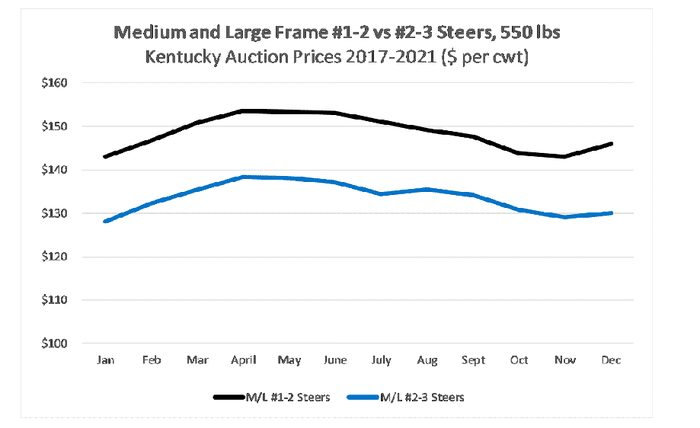June 2, 2022

Over the last year, we have discussed price differentials between bulls and steers, and for weaned calves versus those straight off the cow. In both cases, there are management implications for cow-calf producers. Most of the time, there is a price advantage when steers and for selling preconditioned calves. The producer must decide if that price benefit is sufficient to justify implementing the management practice. In this article, I want to discuss the impact that feeder cattle muscling has on market value. While this is not a year-to-year decision in the same way that castration and preconditioning are, calf muscling is something that producers need to keep in mind as they make long term genetic decisions for their cow-herds.
Feeder cattle are generally graded based on two factors, (1) frame size and (2) muscling. Frame sizes are based on the expected weight of the animal when finished – large, medium, and small. Muscle grades are based on the thickness of the muscle, with a number 1 being the thickest / heaviest muscled.
While there are many ways to estimate the impact of muscling on calf prices, I am going to take a simple historical approach in this article. For market reporting purposes, cattle are often grouped by a combination of frame and muscle grades. For example, market reports typically share prices for Medium and Large Frame #1-2 calves and for Medium and Large Frame #2-3 calves. By comparing these price differences over time, one can get a feel for how much price discount is seen on calves that fall into the lighter muscling category.


The first figure above shows the 5-year average price, by month, for 550 lb steers in these two categories across Kentucky auction markets. The second figure is simply the difference between the two, which can be interpreted as the market discount for lighter muscled steers, as compared to heavier muscled steers. Over the course of the 5 years from January 2017 to December 2021, this discount has averaged $14.83 per cwt, which is more than $80 per head on a 550 lb steer. This is a significant difference in value that will be felt when lighter muscled calves are sold. It is also worth noting that this comparison is for a difference of roughly one muscling grade (#1-2 vs #2-3). Greater discounts would be seen in the market for extremely light muscled cattle.
Given the significant discount that is seen on lighter muscled calves, cow-calf producers need to keep this in mind as they manage their cowherds. Calves with dairy influence will often fall into lighter muscling categories and the same can sometimes happen with under-conditioned calves. However, if significant numbers of calves being sold are taking discounts due to muscling, producers should consider making genetic improvements. This may include improvement in the sires that are used, culling of cows that consistently produce lighter muscled calves, or some combination of both.
Source: University of Kentucky, which is solely responsible for the information provided and is wholly owned by the source. Informa Business Media and all its subsidiaries are not responsible for any of the content contained in this information asset.
You May Also Like




